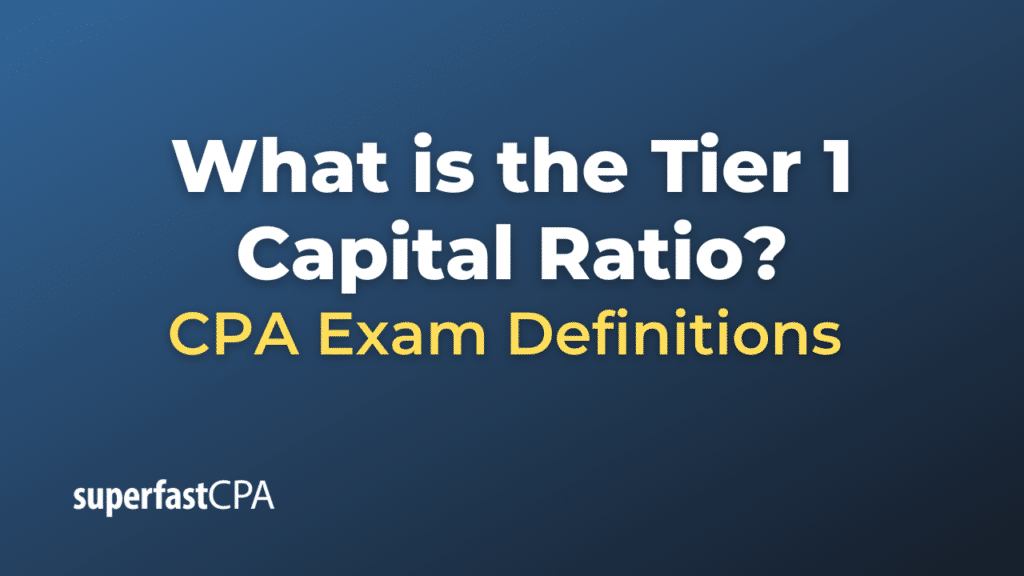Tier 1 Capital Ratio
The Tier 1 Capital Ratio is a key measure of a bank’s financial strength, as seen from a regulator’s perspective. It compares a bank’s core equity capital to its total risk-weighted assets. Essentially, it gauges a bank’s ability to absorb losses without a disruption to its regular operations. The higher the Tier 1 Capital Ratio, the greater the bank’s ability to absorb unexpected financial shocks.
The formula for the Tier 1 Capital Ratio is:
Tier 1 Capital Ratio = Tier 1 Capital / Risk – Weighted Assets
Where:
- Tier 1 Capital typically includes:
- Common equity tier 1 capital: which consists of common stock, retained earnings, and other comprehensive income.
- Additional tier 1 capital: which includes certain types of preferred stock and hybrid capital instruments, among other items.
- Risk-Weighted Assets: This is the total of all assets held by the bank, weighted by credit risk based on regulatory requirements. Different categories of assets (like loans, derivatives, and investments) are assigned different risk weights. For example, government securities might have a risk weight of 0% because they’re seen as risk-free, while a personal loan might have a much higher risk weight.
Regulatory standards, such as those set by the Basel Committee on Banking Supervision (often referred to as Basel III), have specified minimum Tier 1 capital ratios that banks must maintain. Ensuring banks meet these standards is a way to promote the stability of the financial system and prevent banking crises.
For example, under Basel III, the minimum requirement for the Tier 1 capital ratio is set at 6% (of which Common Equity Tier 1 capital must be at least 4.5% of risk-weighted assets), but banks are often encouraged to maintain even higher ratios to ensure additional buffers against potential losses.
Example of the Tier 1 Capital Ratio
Let’s walk through a simplified example to illustrate the Tier 1 Capital Ratio calculation.
Example: Bank ABC
From Bank ABC’s balance sheet and subsequent regulatory adjustments, we identify the following:
- Common Equity Tier 1 Capital:
- Common stock: $5 billion
- Retained earnings: $3 billion
- Other comprehensive income: $500 million
- Less: Goodwill and other intangibles: -$1 billion
- Additional Tier 1 Capital:
- Qualifying preferred stock: $1 billion
- Qualifying hybrid capital instruments: $500 million
- Total Tier 1 Capital = Common Equity Tier 1 Capital + Additional Tier 1 Capital = $7.5 billion + $1.5 billion = $9 billion
Now, let’s look at the risk-weighted assets:
Risk-Weighted Assets: Assume that Bank ABC has the following assets:
- Government bonds: $3 billion (Risk weight = 0%)
- Residential mortgages: $5 billion (Risk weight = 50%)
- Personal loans: $4 billion (Risk weight = 100%)
- Corporate loans: $6 billion (Risk weight = 100%)
Calculating the risk-weighted assets:
- Government bonds: $3 billion × 0% = $0
- Residential mortgages: $5 billion × 50% = $2.5 billion
- Personal loans: $4 billion × 100% = $4 billion
- Corporate loans: $6 billion × 100% = $6 billion
Total Risk-Weighted Assets = $0 + $2.5 billion + $4 billion + $6 billion = $12.5 billion
Finally, using the formula:
Tier 1 Capital Ratio = Tier 1 Capital / Risk – Weighted Assets
Tier 1 Capital Ratio = $9 billion / $12.5 billion = 0.72 or 72%
So, Bank ABC’s Tier 1 Capital Ratio is 72%. This means that 72% of Bank ABC’s risk-weighted assets are covered by its Tier 1 capital, suggesting a strong ability to absorb unexpected losses. Remember, under Basel III, the minimum requirement is 6%, so Bank ABC is well above this threshold.













